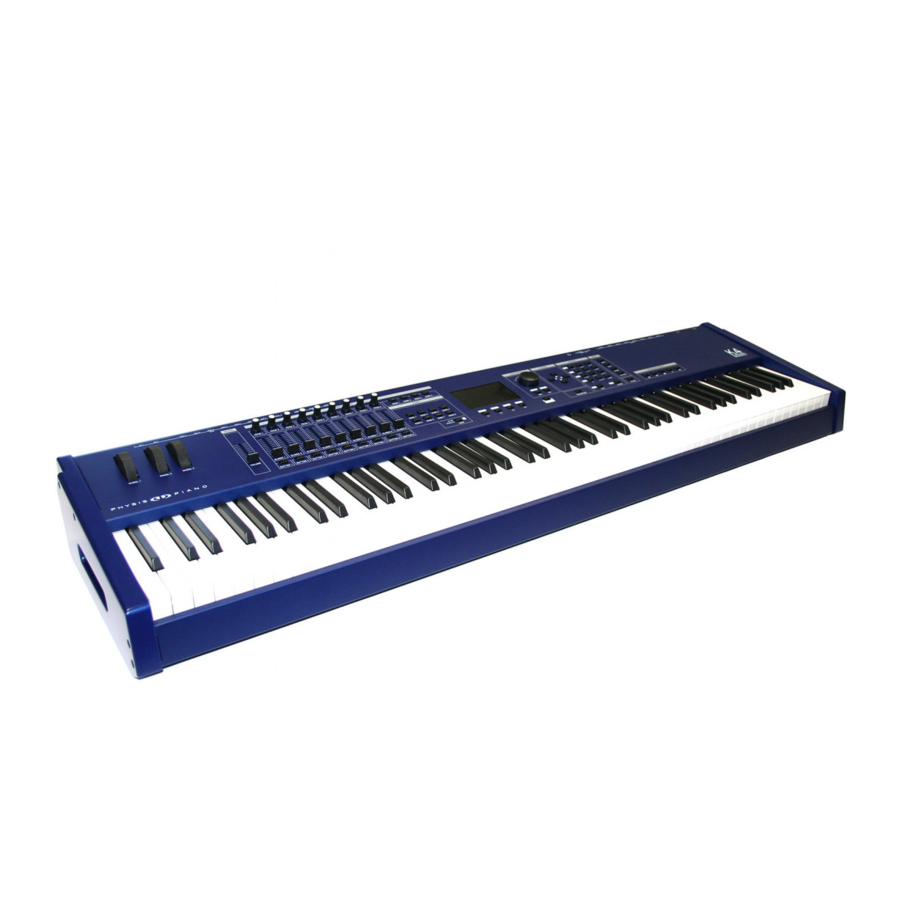
Advertisement
Quick Links
Advertisement

Summarization of Contents
1. IMPORTANT NOTES
1.1 Looking after the product
Instructions for proper care, handling, and placement of the instrument.
1.2 Notes about the manual
Details regarding the manual's content, updates, and copyright information.
2. CONNECTIONS AND CONTROLS
2.1 Front panel
Detailed description of the controls and connectors on the front panel.
2.2 Rear panel
Detailed description of the connectors and buttons on the rear panel.
2.3 Connection examples
Visual examples illustrating how to connect various external devices.
3. K4 / K5 STRUCTURE
3.1 Keyboard
Information about the different types of keyboards available for the instrument.
3.2 Controls
Details on the various control types (wheels, knobs, sliders, buttons, pedals).
3.3 Internal structure
Explanation of the instrument's memory organization and key sections.
4. BASIC FUNCTIONS
4.1 Switching on and main video page
Steps for powering on the instrument and understanding the main display screen.
4.2 Selecting Performance and Scene
Methods for choosing and activating Performances and Scenes.
4.3 Check Zone status
How to view and understand the status of instrument Zones.
4.4 Selecting Control Banks
Process for selecting and managing Control Banks for parameters.
4.5 Keyboard transposition
How to adjust the keyboard's pitch transposition.
4.6 Screen visualisation modes
Explains how to switch between different display view modes.
4.7 Controls information
How to view detailed information about specific instrument controls.
5. CHECKING AND MODIFYING A PERFORMANCE (INFO AND EDIT MODE)
5.1 Foreword on Info and Edit modes
Introduction to the instrument's Info and Edit modes for parameter management.
5.2 Modifying Scene and Performance name
Procedures for renaming Performances, Scenes, and comments.
5.3 Saving a Performance
Instructions on how to save current Performance settings.
5.4 Scenes
How to enable, disable, and manage Scenes within a Performance.
5.5 Zones
Detailed configuration of instrument Zones, including MIDI settings.
5.6 Control Banks
How to program and configure Control Banks for knobs, sliders, and buttons.
5.7 Wheels and pedals
Configuration and calibration of wheels and pedals.
5.8 Additional messages
Setting up custom MIDI messages transmitted upon Scene recall.
5.9 MIDI input maps
Creating and configuring MIDI Input Maps for data routing and filtering.
6. SEQUENCE OF PERFORMANCES (CHAIN MODE)
6.1 Foreword on Chain mode
Introduction to the Chain Mode for creating custom Performance sequences.
6.2 Selecting a Chain
How to recall and activate pre-programmed Performance Chains.
6.3 Programming a Chain
Steps for creating and editing custom Performance Chains.
7. GENERAL INSTRUMENT SETTINGS (SYSTEM MODE)
7.1 Foreword on System Mode
Overview of the System Mode and its accessible functions.
7.2 System MIDI and Preferences
Setting up System MIDI configurations and instrument preferences.
7.3 Instrument Preferences
Customizing graphical and operational settings of the instrument.
7.4 Programming Virtual Instruments
Defining and configuring Virtual Instruments for external device control.
7.5 Configuring System Controls
Calibrating and assigning system functions to pedals, wheels, and aftertouch.
7.6 System Utilities, Update and Factory Reset
Managing system utilities, firmware updates, and factory resets.
8. UTILITY FUNCTIONS AND DATA TRANSFER
8.1 Initialising Scenes
Resetting Scenes to standard default settings.
8.2 Copying Scenes
Procedures for copying Scenes or parts of them to other locations.
8.3 Loading Performances or Virtual Instruments from Internal Memory or USB Drive
How to load saved Performances and Virtual Instruments from storage.
8.4 Saving Performances or Virtual Instruments to the Internal Memory or USB Drive
How to save current Performances and Virtual Instruments to storage.
9. TROUBLESHOOTING
9.1 Error Messages
A list of potential error messages and their explanations.
9.2 Quick Guide for Frequent Problems
Solutions for common operational issues and problems.
10. MIDI
10.1 What is MIDI
An introduction to MIDI technology and its basic concepts.
10.2 MIDI Message Tables
Reference tables for General MIDI program changes and control messages.














Need help?
Do you have a question about the Physis Piano K5 EX and is the answer not in the manual?
Questions and answers